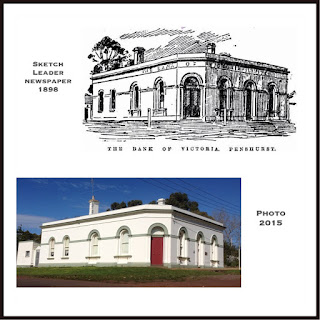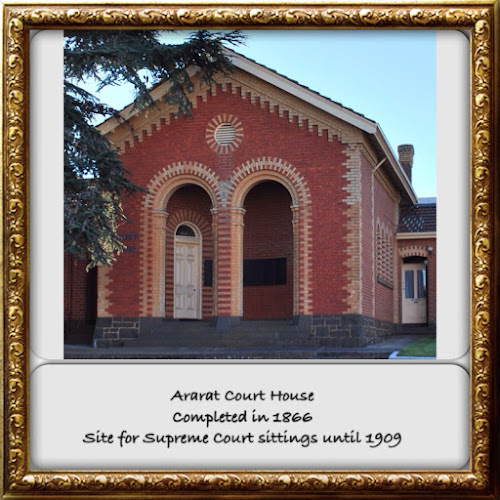General News
Tuesday, 3 November 2015
Penshurst Courthouse - Thursday 11th August 1898
General News
Sunday, 18 October 2015
1948 - Catholic Parish Receives £10,000 Bequest
Wednesday, 2 September 2015
Penshurst Unites to Raise Money for Soldiers Wounded in the War - August 1915
Tuesday, 1 September 2015
Return of the First WW1 Soldier to Penshurst - August 1915
Wednesday, 26 August 2015
Bonnie Whitehead - Princess of Penshurst 1935
Tuesday, 18 August 2015
Thursday 22nd, Friday 23rd and Friday 30th September 1898
Tuesday, 11 August 2015
Monday 8th, Thursday 11th and Thursday 18th August 1898
Monday, 10 August 2015
Friday 5th August 1898
TROVE
TheArgus – Friday 5th August 1898
Friday 5th August 1898
THE ACCUSED IDENTIFIED.
AN OLD POLITICAL OPPONENT OF MR. SHIELS, M.L.A.
ARARAT, Friday.
The accused, who terms himself John Ryan, was identified late last nightas James Slattery, a man well known in the Western district, and formerlysecretary of the Shearers Union at Casterton. Slattery was at one time a mostprominent figure in the labour movements of the Western district, hisconnection with the trades unions and the Australian Natives Association standinghim in such stead that he contested one election against Mr. Shiels, and polled well. In the middleof July, 1896, Slattery came to the front as the perpetrator of a very cleverseries of frauds on share brokers, by means of forging scrip of the Broken HillJunction North Company, and selling it openly in the market. By this means hesold script to the value of £3,000 to various brokers- among whom were Messrs.Wilkinson, Harrison, and Porter, of Adelaide. Ultimately Slattery left Adelaidefor Melbourne with £1300 sovereigns and a bank draft for £1,500. Within a fewdays the fraud was discovered, in consequence of a purchaser who desired his scripdivided into parcels forwarding his scrip to the office of the company in Melbourne.
Detective-sergeant Ward and Detective Macmanamny arrested Slattery inMelbourne through his cashing the draft, and £965 was found in his possession.Of this £400 was lodged to the credit of a young lady, to whom Slattery wasengaged to be married, but directly she learned how it was obtained sherenounced all claim to it. Detective Macmanamny subsequently obtained a fullconfession from Slattery, and he was extradited to South Australia, receivingthree years and a half hard labour at the Adelaide Criminal Sittings on August3, 1896. Though this sentence would not expire until February 3, 1900 Slatterywas, by some means or other released in July last, and apparently has lost notime in getting into mischief again. He is a native of Bendigo, 35 years ofage, and prior to his arrest for forgery was always regarded as an honest andtrustworthy man.
TROVE
EveningNews (Sydney) – Tue 9 August 1898
Friday 5th August 1898
ROBBERY UNDER ARMS
ACCUSED'S CAREER, A LOVE STORY.
The man James Ryan was brought before the police court at Ararat (Vic.)on Friday, and charged with robbery under arms at the Bank of Victoria,Penshurst (Vic.) on August 4.
Superintendent Larkan stated that the police were informed that thePenshurst bank had been robbed at 2.50 on the previous afternoon, and about£600 was taken, and he decided to meet the Hamilton train, which arrived at9.30 p.m. It was believed that the accused got in the train, at Glen Thompson.The police, who were all in plain clothes, were stationed on either side of theplatform as the train came up, and a man was in a second class compartment,huddled up, with his head on one side, and a bandage round his neck. The policetook him to the stationmaster's office, and in his right-hand pocket were founda revolver, fully loaded in five chambers, and 40 cartridges, which, he said,had been given him by a man, whom he did not know. The police, finding nothingin the carriage, went down, to the station yard, and by the side of the linenear Princess street a new strong portmanteau, containing a brief bag and themissing money was found (reports the Melbourne 'Age').
Superintendent Larkan then informed the bench that the man during thenight had washed some of the black off his whiskers. Prisoner denied this,saying that nothing had been given him either to eat or drink. He had only hada pannikin with a little water in it, and if he had washed in that and drankthe water he did well. Then, turning to the superintendent, he added: 'How doyou like that now?' Prisoner is extremely taciturn. He has made no statement tothe police at all, beyond a few words disclaiming all knowledge of the crime.
In the portmanteau, which was obtained at the railway station, and whichis addressed 'James Slattery Warrak, Ararat,' is some black pigment, evidentlythe stuff he had used for dye- ing his whiskers. The portmanteau also containedhis discharge from the Dry Creek labor prison. The accused subsequently admitted his name was James Slattery.
Prior to June 15, 1896, Slattery was known, only to fame as a risingpolitical aspirant, who had been expected by many to wrest from ex- PremierShiels his seat in the Legislative Assembly. At Casterton he was a prominentand well respected man, who took a keen interest in public affairs; but it wasas secretary of the Casterton branch of the Shearers' Union that he was bestknown locally. And an excellent secretary to the shearers' society he made. Itwas a complete revelation, even to those most immediately connected with him,when on the date given Detective Sergeant Ward and Detectives M'Manamny andM'Manus arrested him at a hotel bar in Bourke street and charged him withforging and uttering scrip.
He had been passing under thename of 'E. Long,' and admitted to the detectives that he was the person ofthat name whose accounts in various Melbourne banks amounted to a large total.'I beat the 'books' badly at the Grand National meeting,' he said inexplanation. This proved of no avail, as his identity was soon establishedbeyond doubt.
The forgeries perpetrated by Slattery were in respect of 4000 shares inthe Broken Hill Junction North Company. In nearly every instance this company'sshares were made out in parcels of 100 each, and when the forger prepared aparcel of 500, be made in an otherwise excellently developed scheme, the errorwhich led to the early detection of his crime.
When this parcel came to the hands of 'Mr. J. L. Wharton, the legalmanager of the company in Melbourne, he saw at once that it was a forgery. Areference to the register confirmed the fact. The shares were made out in thename of the legal manager, in trust, such as many more, and for the signa- turewas written 'John L. Wharton, per P. S. Wood, acting manager.' The names werewritten in very good imitation, of Mr. Woods's writing, but the other wordsseemed to be written without attempt at disguise, Mr. Wharton had become awareof Slattery's handwriting through his having brought an action against thecompany for forfeiture of shares. In a visit to Adelaide Mr. Wharton and one ofthe directors obtained information which resulted in the arrest of Slattery.
The circumstances of the company were such that only on comparativelyrare occasions did the scrip reach the hands of the manager, when sales were affected.The case was unlike that, say, of a company making frequent calls. Hence, hadthe parcels all been made of the regular denomination, the crime might havelong remained undiscovered, and Slattery might even now be living in luxuryabroad. The scrip was printed on apparently the same class of paper as thegenuine article, and the signatures were such as an experienced forger mightfeel pride in.' Stamped in crimson ink were the names of two Melbourneshareholders, to demonstrate that the shares were not new. One of these was agood copy of the original, but a shade too large; the other was an exactreproduction. On the back of the scrip, however, a mistake had been made in thesignature of a receipt for payment of a call, 'A. M. Fiedler' appearing Insteadof 'H. M. Fiedler.' The printer's name also appeared in the wrong place.Slattery got the scrip printed at Ballarat, stating that he was an officer ofthe company, and rubber stamps were made for him in Melbourne. The victims ofthe forgeries were Messrs. Wilkinson, Harrison, and Porter, sharebrokers, ofAdelaide, who lost about £3600.
It was ascertained that Slattery paid £400 to a young lady to whom hewas engaged to be married, and whom he had known for five years. The caseagainst Slattery was tried in Adelaide and he received a sentence which expireda few days ago.
It was the fact that he had a toe missing which went to confirm theArarat police in the opinion that the man they had arrested for the bankrobbery was the dealer in scrip. Members of the Casterton Shearers' Union werenot aware that there was anything wrong with Slattery until he was arrested.They surmised— not altogether incorrectly— that he was away on business.' Sodid the members of the local branch of the A.N.A., whose secretary he had been,and whose accounts ''wouldn't add up.'
It was between two and three years .after his defeat by Mr. Shiels thathe was arrested, and in the time intervening he developed a craze for sharespeculation, which was the beginning of his downfall. The history of Slatteryand the young woman referred to has been, peculiarly chequered. When she wasbut 19 years of age she was engaged to be married to Slattery, who was at thetime a prominent shearers' champion, and a prospective labor politician. Shewas heiress to £500 upon coming of age. But when achieved the distinction and themoney Slattery promptly borrowed £400 of it. With this he started a betting andstockbroking career, which led him eventually to the Broken Hill scrip frauds.The proceeds of the frauds were in part devoted to the settlement of thisliability, but the young woman was honorable enough so soon as she learned thesource from which the money came to hand it all over to the police.
It is curious that subsequently she entered the service of Mr. Gosslett,late manager of the Bank of Victoria at Penshurst, the institution which hasjust been robbed by her old- time lover. She left the situation some time ago,but kept up a correspondence with Slattery, and probably it was the desire tosee her which brought him back to the district in which he had been formerlywell known.
The two had appointed to meet at Ararat on Saturday last, and the youngwoman was on the station awaiting the train, when she heard of Slattery'sarrest. It is said they were to be married; if so, the bridal day has sadlymiscarried. On Saturday afternoon, when Slattery was taken back to Hamilton,the young woman was at the station to see him. The sight of him, crestfallen,doggedly silent, and wearing piebald hair, was, however, too much for her, andshe burst into loud and hysterical crying, and had to be taken home from thestation in a cab. Slattery was unmoved.
A Warrnambool wire states: Therailway authorities have received a report that a ganger's wife saw two mencutting the telegraph wires near Penshurst on Thursday afternoon, but at thetime she thought they were line repairers. This points to the conclusion thatthe bank robber Slattery had accomplices.














